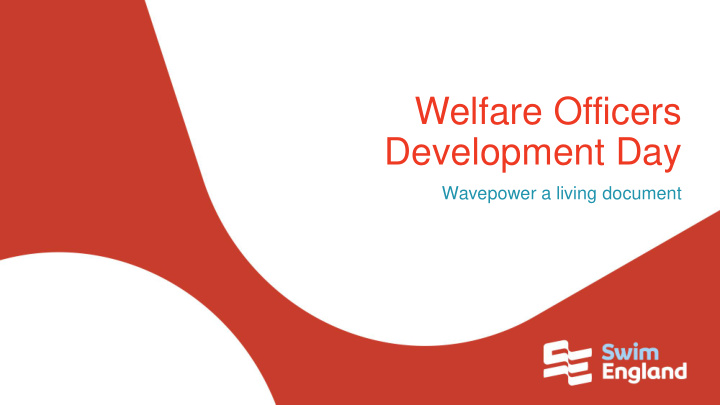



Welfare Officers Development Day Wavepower a living document
The Safeguarding Team County Welfare Regional Welfare Club Welfare Officers Officers Officers Joanne Garey National Child Safeguarding Officer Keith Oddy National Safeguarding Independent Child Team Protection Officer Jenni Dearman National Child Safeguarding Manager
The role of the Welfare Officer To be aware of, and have a Raise awareness note of safeguarding contact and implement details -Police, LADO, MASH, Wavepower safeguarding partners, the National safeguarding team Ensure members know how to contact you and access To ensure confidentiality is Core the safeguarding maintained and arrangements within the Tasks information is shared on a club ‘need to know’ basis To act in the best Ensure concerns are interest of the correctly referred child and reported
Front page of Wavepower To be aware of, and have a note of safeguarding contact details -Police, LADO, MASH, safeguarding partners, the National safeguarding team
Not all concerns / complaints are child safeguarding • Many of the concerns raised are breaches of the club or Swim England’s Rules and breaches of Code of Ethics and accompanying code of conducts rather than child safeguarding / protection. - General poor behaviour which breaches the Code of Ethics and Codes of Conduct. - Breakdown in communication between members at the club including children and parents. - Disciplinary matters. • Coaching techniques – can be raised under the Coaches referral protocol. • Medical conditions / issues causing concern – Medical Protocol. • Further information on all of the above can be sought from the OJA on 0161 244 5345 or from the website link https://www.swimming.org/members/how-to-resolve-issues-with-your-club/
Wavepower a living Document and some of the most common concerns which arise.
Self Harm
What is Self-Harm and who does it? Self-Harm (self-injury) is a term used to describe a wide range of behaviours where individuals intentionally hurt themselves – • Cutting • Rubbing / scraping the skin with sharp objects • Scratching, picking and pinching of skin • Biting yourself • Burning • Hitting objects, including punching and head banging • Poisoning or overdosing • Eating disorders • Exercising excessively
Youngminds #noharmdone - Responding to self harm
Swim England Medical Protocol • Under this Protocol the Doctor can be asked to speak to the young person’s doctor / consultant to discuss this further if there is doubt as to whether a child's self injury makes an assessment on their fitness to swim necessary • Requests will always be advised on a case-by-case basis. • Following this referral process the Swim England Doctor will be able to confirm, or otherwise, the fitness to swim and whether any additional support can be given by the club to enable the young person to continue in the sport.
Organisations which can help GP’s who can refer to specialist mental health services – Child and Adolescent Mental Health Services (CAMHS) Young minds (http://www.youngminds.org.uk) Self Harm UK (https://www.selfharm.co.uk) • Virtual college free course – https://www.virtual-college.co.uk/news/virtual-college/2017/02/self- harm-course-launch
#noharmdone - Things can change.
Changing Rooms
How big is the problem? • The NSPCC reported in recent years police had seen annual reports of this nature triple in numbers. • Compared to last year Swim England have seen a large increase, 95% (from 66%) of incidents related to taking / possessing / sending / circulating of child abuse images. • When it happened “in sport” - two thirds committing this were children. • Most of these offences are committed by boys taking / trying to take indecent images of girls
What should you do?
Measures to tackle problems • Reinforce Wavepower guidance • Working with facilities to “design out” • Speak with your facility provider • Segregation and natural barriers • Education
W ho’s responsibility? It’s everyone’s responsibility Shared with public Private use • Under the duty of care to safeguard There is a shared responsibility and it is children, the club has a responsibility for the important that a conversation is had with the wellbeing of children in changing rooms. facility to discuss this. • Parents also have a responsibility • Clubs must make clear to parents under what circumstances they require parents to remain at the pool.
Update on what the NGB is currently working on with regards to safeguarding.
Club Hub https://www.swimming.org/swimengland/clubs-home/ • Developed by the club development / volunteering team • Provides a lot of useful information which may help a club
Wavepower • Wavepower is being updated • Tried to reflect and strength policies in line with what we have coming through. • Better online presences
Child and teen resource • New child and teen resources being developed • Content made by the Youth Advisory Panel • The aim of both resources is to encourage children to talk and raise awareness that if you are not happy speak to someone.
Child Resource
Teen Resource
Poster
Bespoke safeguarding training • Working on creating our own Swim England Safeguarding Training. • Specific to aquatics and be able to provide scenarios. • Is there any topics which you as welfare officers / club members may find useful as refresher training?
joanne.garey@swimming.org 01509 640252
Recommend
More recommend